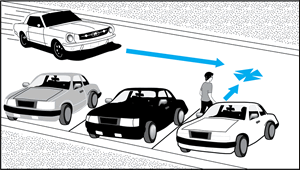

Safety analysis tools upgraded for crash data research
For researchers in need of crash data for conducting research, the Highway Safety Information System (HSIS) is a great resource. HSIS, operated by the UNC Highway Safety Research Center for the Federal Highway Administration, is a multi-state database that contains crash, roadway inventory and traffic volume data for a select group of states and urban centers. In addition to the management of the data, HSIS researchers are also involved in the development of analysis tools that make use of crash data. Two specific tools have recently been updated and are available for download through the HSIS web site (www.hsisinfo.org).

The Pedestrian and Bicycle Crash Analysis Tool (PBCAT) is a crash typing software product intended to assist state and local pedestrian/bicycle coordinators, planners and engineers with improving walking and bicycling safety through the development and analysis of a database containing details associated with crashes between motor vehicles and pedestrians or bicyclists. One of these details is crash type, which describes the pre-crash actions of the involved parties. After developing a database of crash information, PBCAT users can analyze the data, produce reports and select countermeasures to address the problems identified by the software.
PBCAT Version 2.0 includes significant improvements in functionality and has an enhanced design that makes the software easier to use. Some features of PBCAT Version 2.0 include:
- User-friendly environment and improved navigation
- Operates in a Microsoft® Windows® environment and includes easy-to-use pulldown menus and toolbars.
- Form Designer
- Users can customize the form for inputting crash data and design it to match the police crash reports used in their community.
- Location Data
- Users have the option of recording specific location information, such as approach and travel direction, for pedestrian crashes occurring at intersections.
- Crash Reports
- Users can produce single-variable and multi-variable tables within the application and export the results to Microsoft Excel® for further customization and graphics production.
- Expert System Tools
- To help users select appropriate countermeasures, PBCAT Version 2.0 includes links to the Web-based Pedestrian Safety Guide and Countermeasure Selection System (PEDSAFE), and the Bicycle Countermeasure Selection System (BIKESAFE).
The Geographical Information System (GIS) Safety Analysis Tools have been upgraded to operate within the ArcGIS environment. Computerized crash analysis systems in which crash data, roadway inventory data and traffic operations data can be merged are used in many states and municipalities to identify problem locations and assess the effectiveness of implemented countermeasures. By integrating this traditional system with a GIS, which offers spatial referencing capabilities and graphical displays, a more effective crash analysis program can be realized. The crash evaluation tools in Version 4.0 of the software include:
- Spot/Intersection Analysis
- used to evaluate crashes at a user-designated spot or intersection within a given search radius.
- Strip Analysis
- used to study crashes along a designated length of roadway as opposed to a spot or intersection.
- Cluster Analysis
- used to study crashes clustered around a given roadway feature such as a bridge, railroad crossing, or traffic signal.
- Sliding-Scale Analysis
- used to identify roadway segments with a high crash occurrence. This program differs from the Strip Analysis program in that the analysis segment is not fixed, but rather slides along the route in an incremental fashion.
- Corridor Analysis
- used to locate high crash concentrations within a corridor. This program allows routes to be linked together in a manner that allows the analyst to assess the overall safety performance within a transportation corridor.
The University of North Carolina Highway Safety Research Center
730 Martin Luther King Jr. Blvd, Suite 300 | Campus
Box 3430 | Chapel Hill, NC 27599-3430
Phone: 919.962.2203 | Fax: 919.962.8710
http://www.hsrc.unc.edu